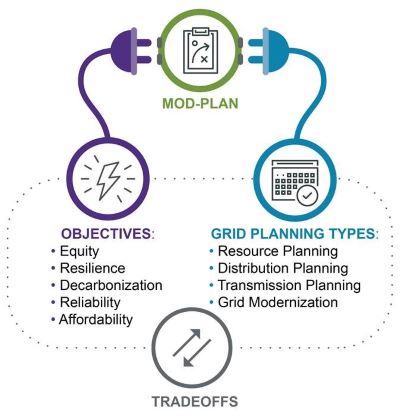



Overview
The electric grid Multi-objective Grid Planning helps grid planning frameworks better account for—and indicate tradeoffs between—emerging objectives for energy justice and resilience, alongside traditional grid planning objectives.

Traditionally, electric grid planning strives to maintain safe, reliable, efficient, and affordable service for current and future customers. As social expectations and policies evolve, additional considerations for grid planning are emerging, such as energy justice and equity and resilience. The increased frequency and severity of natural disasters over the last two decades and cybersecurity concerns have elevated resilience as a key planning objective. More recently, energy justice and energy equity has emerged as an important consideration to ensure that disadvantaged communities are not adversely affected by grid modernization and have equal access to its benefits.
Traditional planning frameworks must address these new planning goals of energy justice and equity and resilience. To do so, planning frameworks require new methods to be incorporated into current practices. In addition, a practical approach is needed to form balanced strategies that address the full set of grid planning goals.
Sandia National Laboratories and Pacific Northwest National Laboratory support DOE objectives through applied research on Multi-Objective Decision Planning focused on advancing traditional grid planning methodologies to incorporate energy justice and equity and resilience goals.
In our work, we:
- Develop modeling frameworks that can apply multiple, emerging objectives in electric grid planning processes,
- Advance practical methods for grid planning for objective formulation, data utilization, and tradeoff assessments for decarbonization, resilience, and energy justice and equity objectives, and
- Develop and report metrics and associated methods to measure and evaluate electric grid performance with respect to decarbonization, resilience, and energy justice and equity objectives.
Research Areas
On the other side of the meter, people and communities experience electric service differently, with varying levels of affordability or vulnerability to lower levels of reliability.
Many historically disadvantaged communities face high financial burdens for electric service, poor levels of grid resilience, unequal access to clean energy opportunities, and/or energy-related environmental deterioration and damage.
Addressing these inequities through grid planning can expand to investigate the social dimensions of electricity system delivery and investments, but it is a multi-dimensional and multi-disciplinary problem.
An attribute of the grid that supports these emerging objectives is flexibility.
The degree to which the electric system is flexible may allow more manageable and cost-effective integration of renewable energy resources at increasing levels, facilitate stronger grids and system- and local-scale buffering, and enable social objectives by assuring reliable and affordable electric service.
Planners may use flexibility metrics as a proxy for evaluating progress toward objectives.
Because of the highly consequential nature of extreme and acute disruptions, such as natural disasters, planning for local and systemic resilience requires fundamentally different approaches and tools than planning for other objectives.
Through new, performance-based resilience quantification approaches, our research enables resilience to be considered and weighed directly alongside other objectives.
To evaluate alternative scenarios for the future grid, planners must be able to compare decarbonization, resilience, and energy justice and equity objectives against each other and against traditional objectives, such as affordability, reliability, and safety.
This program is developing a multi-objective planning process, along with providing insight into novel metrics, methods, and tools to support this planning process.
Partnerships
The U.S. Department of Energy, Sandia National Laboratories, and Pacific Northwest National Laboratory are working together as partners on this joint program. Sandia and PNNL are engaged with stakeholders around the country to guide and give new perspectives for the ongoing research.
Documents
Contact
Sandia National Laboratories
Brian J. Pierre, Ph.D
Manager, Electric Power Systems Research Department
(505) 284-7955
bjpierr@sandia.gov
Pacific Northwest National Laboratory
Rebecca O’Neil
(971) 940-7098
rebecca.oneil@pnnl.gov
U.S. Department of Energy
Joseph Paladino
joseph.paladino@hq.doe.gov